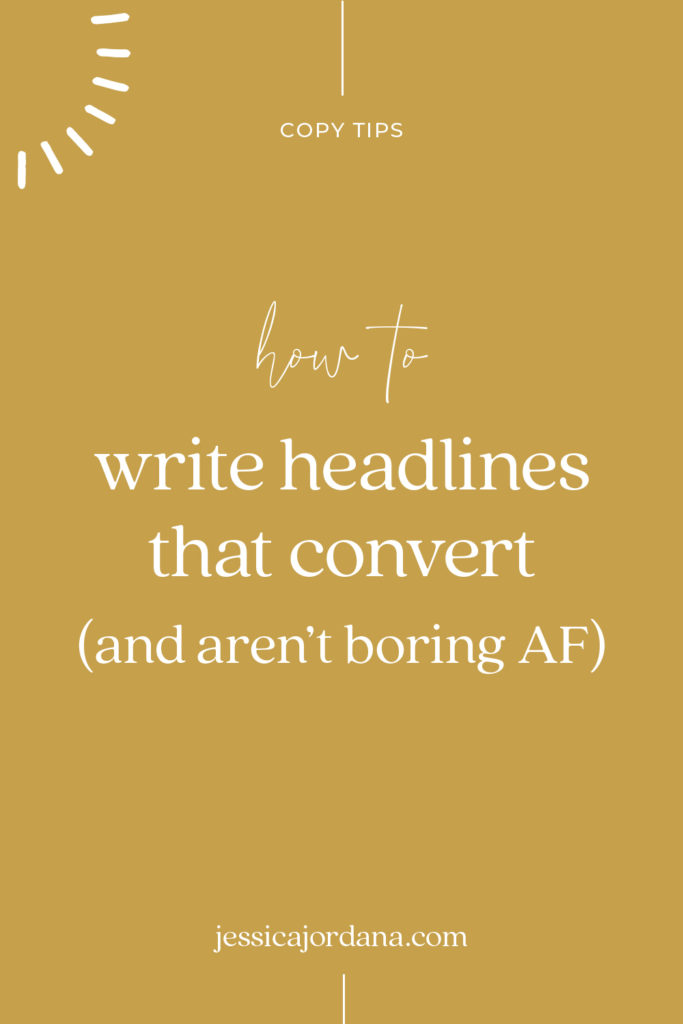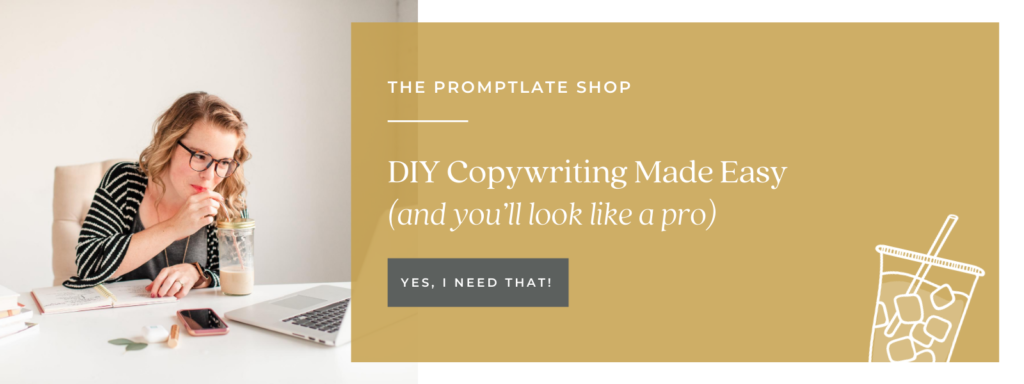How to Write Headlines That Convert (And Aren’t Boring AF)
October 15, 2020
Do you ever feel a stupid amount of pressure when it comes to writing headlines?
Truthfully, even after 3+ years in copywriting, I sometimes do, too.
I typically write the same headline at least 25 different ways when writing copy for my 1:1 clients.
I don’t expect you to have that kinda time on your hands, and it feels like no one is really paying you when you’re writing copy for your own business.
It makes sense why so many business owners (copywriters included) feel the heat for writing a solid headline, since, y’know, it’s the first and biggest thing your ideal client will read on your website, in your blog, in your emails, and even your Instagram bio.
Plus, knowing that about 80% of people read the headline, but only 20% of people read the entire post… the stakes feel much higher.
If you’re tired of thinking to yourself things like…
- “If I don’t write the PERFECT headline, then all this hard work will have been for nothing.”
- “I have SO much value to share, but I can’t think of a catchy headline to make my ideal client want to click.”
- “There are so many posts in my drafts ready to go, but I’ve been stewing on a clever headline for weeks… when will I finally figure out how to kick off this awesome content?”
…then I’m about to rock. your. world and take the headline-writing process from painful to painless.
Follow these 3 tips to beat headline-writing paralysis and feel confident writing compelling headlines in ALL your content moving forward.

3 Tips to Write Compelling Headlines That Convert
Refer to the 4 U’s: Useful, Urgent, Unique, Ultra-Specific
I learned this method from the copywriting trainers at American Writers & Artists, and it’s broken down so beautifully. It will make your approach to writing headlines feel way less daunting and, most importantly, more fun!
When writing a headline, a crosshead (a.k.a. a subheading), or even a bullet list, we want to keep the 4 U’s in mind:
- Be useful to the reader
- Provide your ideal client with a sense of urgency
- Talk about how the main benefit is unique
- Be ultra-specific in how you do all of the above
Depending on whether you’re writing a main headline or a crosshead, you may not be able to fit all of the first 3 U’s (useful, urgency, uniqueness)—but you’ll want at least 2 of the 3 to be present in all of your headlines.
Let’s break down a couple examples from previous blog posts:
Example 1: Copy Hack: How to Hook More of the RIGHT People with One Sentence
- ‘Copy Hack’ and ‘How to’ introduce the post as being useful because we’re teaching the reader something
- Capitalizing RIGHT creates a sense of urgency because it implies that you may not be already doing that without this hack
- ‘with One Sentence’ shows how this content is both unique and ultra-specific
Example 2: 6 Ways to Maximize Pinterest Traffic Using Copy that Converts
- This entire headline clues the reader into knowing they are about to learn an ultra-specific, useful skill
- ‘Using Copy that Converts’ is presented as the unique approach to maximizing Pinterest traffic
See how even incorporating just 3 of the 4 U’s clearly communicates what they’re about to dive into, how it will help them, and why they should care? Not only does this structure allow you to give clarity, but it also leaves room to be clever and let your brand voice shine through.
If that’s the main hurdle you’re looking to clear when writing headlines, pay close attention to my next tip.
Use Parallel Structure
I gave this tip in my post about writing copy that sticks, and it translates super well to writing headlines and crossheads, too.
As a reminder, parallel structure is when you see copy take the same format and structure (ex: name → preposition → number) back to back.
Now, this can begin to sound generic realllll quick, as I’m sure you’ve noticed yourself. Apparently there are LOTS of women who like to identify as “Mom of 2. Wife to 1.” out there.
There’s nothing wrong with that, of course, but let’s mix it up a bit to really captivate your audience. This technique works best for web headlines/crossheads, email headlines, and Instagram bios, rather than the title of a blog post.
Here are a couple more examples to demonstrate this technique for ya:
Example 1: The secret to writing a killer headline without causing a killer headache
See how “writing a killer headline” has parallel structure to “causing a killer headache”? The verb tense is the same (writing and causing), and it helps that both nouns (headline and headache) are spelled similarly.
Example 2: Simple DIY web copy for the not-so-simple DIY gal
This example presents parallel structure in an opposing way, with Simple DIY’ with ‘not-so-simple DIY’.
While these two examples aren’t quite similar to the structure of the original example (Mom of 2. Wife to 1.), that’s the exact reason why they stand out!
And, tying it back to Tip #1, both demonstrate a unique benefit and usefulness for the reader.
Answer the question: “Is this for me?”
This final tip will be especially useful for writing headlines on your Homepage, About page, and your Instagram bio.
For this point, I’m reviving one other example from another blog post of mine (and from a headline example above!)—how to hook more of the RIGHT people with one sentence.
My biggest takeaway from that post is that the one question every visitor asks the moment they land on your website is, “Is this for me?”
Your headlines and crossheads will play a MAJOR role in determining whether or not the answer to that question is yes or no.
At the most basic level, these headlines should communicate what you do, who you do it for, and how you do it differently. This is where we can start to play a little bit and make your ideal client stop their scroll.
Relating it back to Tip #1 again, the key here is being ultra-specific with presenting the what + who + how.
Let’s close out this section with a couple final examples for you to peek at:
Example 1: Copywriting for Creatives with SO MUCH to say & NO CLUE how to say it
This example is ultra-specific, staying clear of generic terms like “busy” or “overwhelmed.” This calls to a more specific reason why your ideal client needs your support. As I mentioned in this post, it helps weed out other creatives who may not totally fit the bill of your ideal client—which is ALWAYS a win-win.
Example 2: The 24/7, Live-In Nanny for WFH Mamas
Most people wouldn’t expect a nanny to niche down specifically for professional moms who work from home, but the specificity is exactly what’s needed to speak directly to her ideal client and get quality leads.
It also clearly states the what (nanny) for whom (WFH mamas) and the how (24/7, Live-In), while still maintaining brand voice with the use of an acronym and the informal term “mamas” versus “mothers.”
Ready for your website copy to finally convert consistently?
If your answer is a resounding YES, then you’re gonna wanna check out The Promptlate Shop where I walk you through the process of writing words for your business, so you can have the confidence to put them out into the world.

It’s the very first solution of its kind to help you take #alltheideas inside your head and turn them into website copy that connects, converts, and doesn’t sound like literally everyone else’s.
Think your copy needs a makeover? Then, it probably does.
You’ve gotta capture, connect, and convert—FAST. No big deal, right?
SHOP THE PROMPTLATES
Introducing: The Promptlate Shop